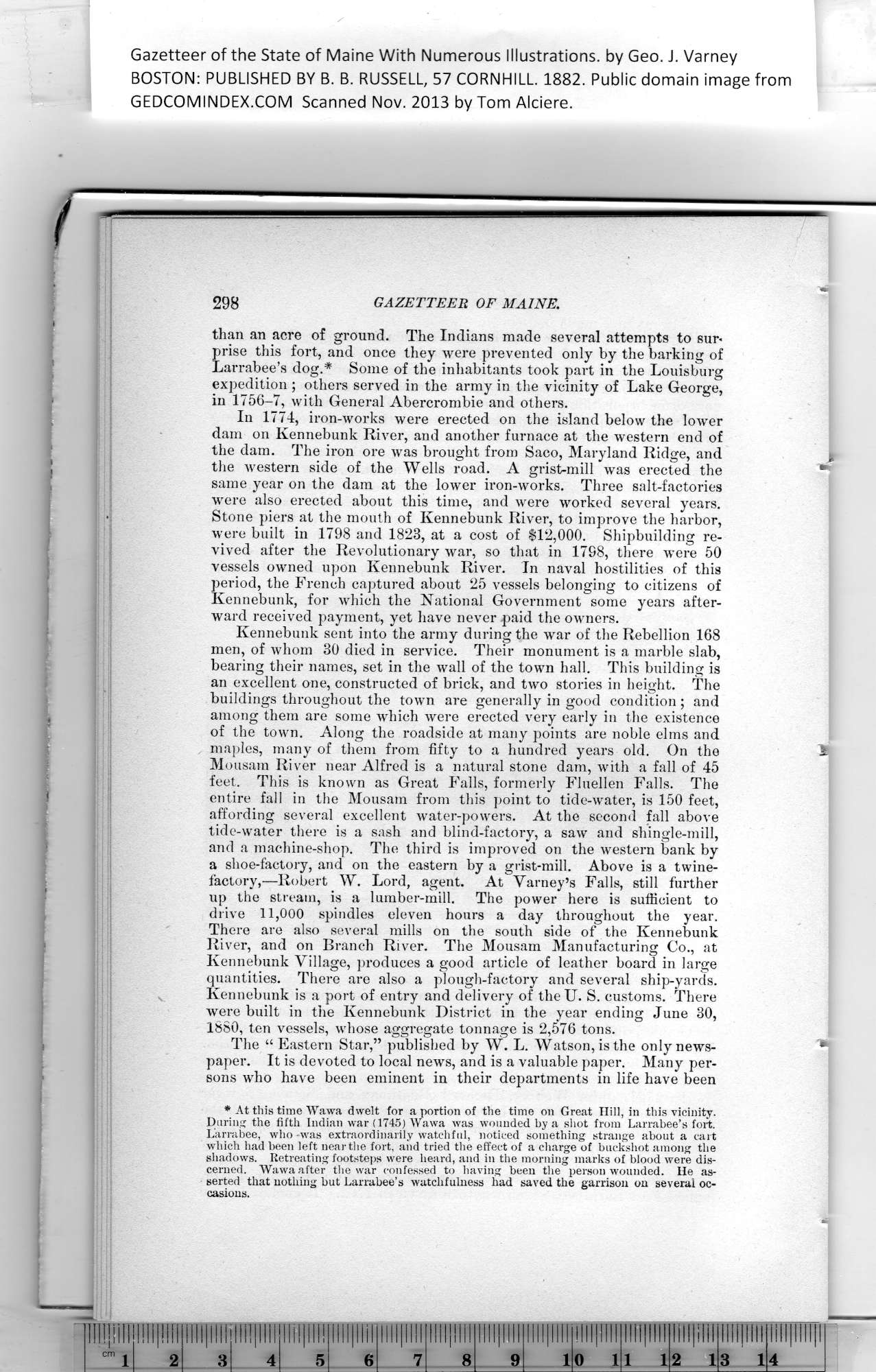|
Gazetteer of the State of Maine With Numerous Illustrations, by Geo. J. Varney
BOSTON: PUBLISHED BY B. B. RUSSELL, 57 CORNHILL. 1882. Public domain image from
298 GAZETTEER OF MAINE.
than an acre of ground. The Indians made several attempts to sur-
prise this fort, and once they were prevented only by the barking of
Larrabee’s dog.1 Some of the inhabitants took part in the Louisburg
expedition ; others served in tbe army in the vicinity of Lake George,
in 1756-7, with General Abercrombie and others.
In 1774, iron-works were erected on the island below the lower
dam on Kennebunk River, and another furnace at the western end of
the dam. The iron ore was brought from Saco, Maryland Ridge, and ,
the western side of the Wells road. A grist-mill was erected the 1fcr
same year on the dam at the lower iron-works. Three salt-factories
were also erected about this time, and were worked several years.
Stone piers at the mouth of Kennebunk River, to improve the harbor,
were built in 1798 and 1823, at a cost of $12,000. Shipbuilding re-
vived after the Revolutionary war, so that in 1798, there were 50
vessels owned upon Kennebunk River. In naval hostilities of this
period, the French captured about 25 vessels belonging to citizens of
Kennebunk, for which the National Government some years after-
ward received payment, yet have never paid the owners.
Kennebunk sent into tbe army during the war of the Rebellion 168
men, of whom 30 died in service. Their monument is a marble slab,
bearing their names, set in the wall of the town hall. This building is
an excellent one, constructed of brick, and two stories in height. The
buildings throughout the town are generally in good condition; and
among them are some which were erected very early in the existence
of tbe town. Along the roadside at many points are noble elms and
maples, many of them from fifty to a hundred years old. On the \
Mousam River near Alfred is a natural stone dam, with a fall of 45
feet. This is known as Great Falls, formerly Fluellen Falls. The
entire fall in the Mousam from this point to tide-water, is 150 feet,
affording several excellent water-powers. At the second fall above
tide-water there is a sash and blind-factory, a saw and shingle-mill,
and a machine-shop. The third is improved on the western bank by
a shoe-factory, and on the eastern by a grist-mill. Above is a twine-
factory,—Robert W. Lord, agent. At Varney’s Falls, still further
up the stream, is a lumber-mill. The power here is sufficient to
drive 11,000 spindles eleven hours a day throughout the year.
There are also several mills on the south side of the Kennebunk
River, and on Branch River. The Mousam Manufacturing Co., at
Kennebunk Village, produces a good article of leather board in large
quantities. There are also a plough-factory aud several ship-yards.
Kennebunk is a port of entry and delivery of theU. S. customs. There
were built in the Kennebunk District in the year ending June 30,
1880, ten vessels, whose aggregate tonnage is 2,576 tons.
The “ Eastern Star,” published by W. L. Watson, is the only news- *
paper. It is devoted to local news, and is a valuable paper. Many per-
sons who have been eminent in their departments in life have been
1
At this time Wawa dwelt for a portion of the time on Great Hill, in this vicinity.
During the fifth Indian war (1745) Wawa was wounded by a shot from Larrabee’s fort.
L'arrabee, who was extraordinarily watchful, noticed something strange about a cart
which had been left near the fort, and tried the effect of a charge of buckshot among the
shadows. Retreating footsteps were heard, and in the morning marks of blood were dis-
cerned. Wawa after the war confessed to having been the person wounded. He as-
serted that nothing but Larrabee’s watchfulness had saved the garrison on several oc-
casions.
PREVIOUS PAGE ... NEXT PAGE
This page was written in HTML using a program written in Python 3.2
| 